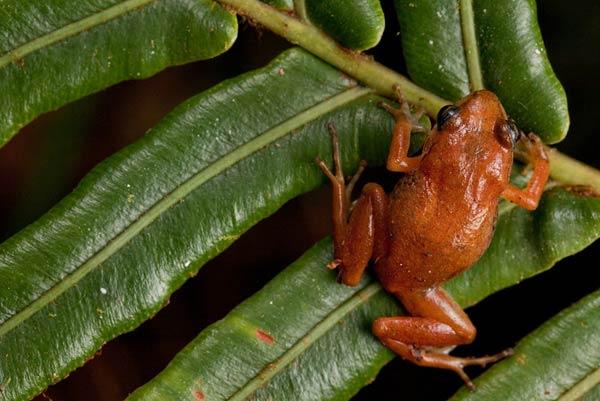
6 'Lost' Frogs Rediscovered in Haiti's Forests

The reappearance of six globally unique — and thought to be lost — frog species in the tropical jungles of Haiti may provide hope for the beleaguered country's wildlife.
Scientists from Conservation International (CI) and the Amphibian Specialist Group (ASG) of the International Union for Conservation of Nature (IUCN) announced yesterday (Jan. 11) that the frogs, which hadn't been seen by scientists in two decades, had been spotted. [See images of the frogs here.]
The mission was part of Conservation International's Search for Lost Frogs, a hunt to locate species that have not been seen in a decade or more and which are feared to be extinct. The search, which now includes 19 different countries on five continents, has led to three species rediscoveries in the past six months.
The group was originally on the lookout for one particular species — the long-lost La Selle Grass frog (E. glanduliferoides). The species had not been seen in more than 25 years.
"It was incredible," said Robin Moore, CI's amphibian conservation specialist. "We went in looking for one missing species and found a treasure trove of others. That, to me, represents a welcome dose of resilience and hope for the people and wildlife of Haiti."
Haiti's forests have been plagued by large-scale deforestation, which has left the country with less than two percent of its original forest cover. The cloud forests of the country's southwest mountains stand as two of the last remaining pockets of environmental health in Haiti. One of these, the Massif de la Hotte, has been highlighted by the Alliance for Zero Extinction (AZE) as the third-highest site-level conservation priority in the world, with 15 endemic amphibian species found there and nowhere else.
"The ecosystems these frogs inhabit, and their ability to support life, is critically important to the long-term well-being of Haiti's people," Moore said. "Amphibians are what we call barometer species of our planet's health. They're like the canaries in the coal mine. As they disappear, so too do the natural resources people depend upon to survive."
Sign up for the Live Science daily newsletter now
Get the world’s most fascinating discoveries delivered straight to your inbox.
While there are still environmentally rich regions of Haitian forest intact, these areas are all faced with tremendous environmental pressure, and it is only a matter of time before they too are destroyed. Haiti's amphibian populations are in danger of disappearing.
A total of 92 percent of the country's amphibian species are listed as threatened, while globally, more than 30 percent of all amphibian species are threatened with extinction.
"Haiti now has the opportunity to design their reconstruction plans around these pockets, and grow them, so they can more effectively act as natural buffers to climate change and natural disasters," Moore said.
Among the team's amphibian rediscoveries are the following six species, which are all listed as critically endangered:
- Hispaniolan Ventriloquial Frog – last seen in 1991 (Eleutherodactylus dolomedes)
- Mozart's Frog – last seen in 1991 (E. amadeus)
- La Hotte Glanded Frog – last seen in 1991 (E. glandulifer)
- Macaya Breast-spot Frog – last seen in 1991 (E. thorectes)
- Hispaniolan Crowned Frog – last seen in 1991 (E. corona)
- Macaya Burrowing Frog - last seen in 1996 (E. parapelates)
"Finding six lost species in these relatively small corners of the country tells us that, despite tremendous human pressures, nature is hanging on in Haiti," Moore said. "Managed properly, these species and ecosystems can become a source of natural wealth and national pride for the country that we hope will offer long-term benefits for its people."
- Mug Shots: 10 Lost Amphibians
- Scientists: Haiti's Wildlife Faces Mass Extinction
- 8 of the World's Most Endangered Places
This story was provided by OurAmazingPlanet, a sister site of LiveScience.











